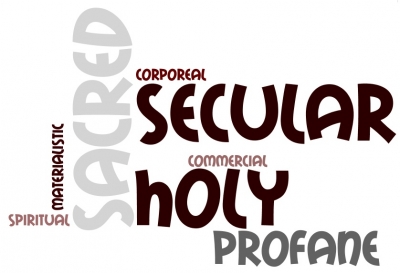Holy Places: Islands?
Where are holy places? And conversely are not holy places? Can there be such a thing as an anti-holy place (as opposed to an unholy place)? While these may seem like questions with obvious answers, they actually touch on larger ideas that are worth exploring a little.
In general, the Western conception of holy places, following Judea-Christian and Greco-Roman thought, is that holy places are distinct special spaces. That is, holy places are like islands of sacredness in the surrounding secular world. They are marked out from the rest of the world and are treat differently. This strict demarkation is found in ancient Greece shrines to the gods or in the traditions concerning the Hebrew Temple. Although, Christianity was initially opposed to the concept of holy places – as it was a universal faith not to be restricted by either location or ethnicity – it gradually took on these ideas, for example the ideas of monasteries as being separate from the rest of the world.
This schema is still a well-established contemporary concept. Equally, it can be present in descriptions of natural or new age sites of spirituality whereby certain locations are deemed to have a special character, that they are in some way closer to another plain or sphere of an other, the spiritual or the divine.

Stalls selling holy items in Knock a Marion apparition pilgrimage in the West of Ireland. It shows an intermixing of the sacred and the profane.
However, some academic discussions of holy places are proposing that we should not treat the profane and the holy as being disconnected. On greater consideration, it can be seen that there is a blurring and entwining of the two spheres. No space can be entirely one or the other. Sacred spaces frequently contain commercial areas, with the larger religious sites having vast industries centred on them; for example, the stalls found lining the streets of pilgrimage sites or souvenir shops in famous Cathedrals. Conversely, profane spaces have numerous religious and spiritual elements: streetscapes are filled with religious iconography or names and airports and hospitals contain prayer rooms and chapels. Moreover, perspectives which see nature and the natural world as inherently sacred disrupted simple dichotomies.

A way of viewing the intermixing of the sacred and the profane in the world. Word cloud generated at wordle.net
Like, many aspects of contemporary thinking, a scale or a spectrum might be a more suitable way of conceiving of the sacred and profane, or, at the very least, a venn-diagram. Models based on clear categories are being increasingly challenged, not necessarily because the modern world is any porous or mobile than before, but because we are increasingly recognising that it was always so, in some ways anyway.
Possible Readings:
Gesler, W.M. 1996. Lourdes: healing in a place of pilgrimage. Health and Place, 2 (2), pp. 95-105.
Hughes, J. D. and Swan, J. 1986. How Much of the Earth Is Sacred Space? Environmental Review: ER, 10 (4), pp. 247-259.
Kong, L., 2001, ‘Mapping ‘new’ geographies of religion: politics and poetics in modernity’, Progress in Human Geography, 25 (2), 211–233.
Yorgason, E. and della Dora, V. 2009. Editorial: Geography, religion, and emerging paradigms: problematizing the dialogue. Social & Cultural Geography, 10 (6), 629-637.
Also, Sacred spaces in Profane Buildings seems like an interesting project.
